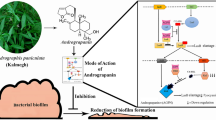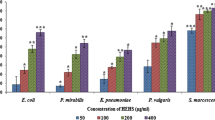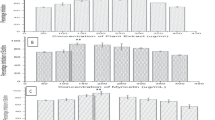Abstract
14-Deoxy-11,12-didehydroandrographolide is a biologically active molecule present in the extract of Andrographis paniculata (Kalmegh), a classic ethnic herbal formula, which has been used for over thousand years as therapeutics to treat numerous infectious diseases like upper respiratory tract infection, urinary tract infection, and many more health issues. The present study is designed to ascertain an inhibitor against biofilm formation from the major metabolites of Andrographis paniculata, because the extract of this herb shows inhibition of bacterial quorum sensing (QS) communication and biofilm development against microorganisms. 14-Deoxy-11,12-didehydroandrographolide at 0.1 mM (sub-MIC dose) with azithromycin (6 μg/mL, sub-MIC) or gentamicin (4 μg/mL, sub-MIC) synergistically inhibits 92% biofilm production by a 48-h treatment against Pseudomonas aeruginosa. Further investigation carried out by atomic force microscopy shows promising reduction in roughness and height of biofilm in the presence of 14-deoxy-11,12-didehydroandrographolide compared with the control group. The content of extracellular polymeric substances, level of pyocyanin production, and synthesis of extracellular protease by P. aeruginosa have also been reduced significantly at around 90% in 14-deoxy-11,12-didehydroandrographolide-treated group. In conclusion, 14-deoxy-11,12-didehydroandrographolide could be used as a drug molecule against biofilm development by inhibiting QS pathway in Pseudomonas aeruginosa.







Similar content being viewed by others
References
Hancke J, Burgos R, Caceres D, Wikman G (1995) A double-blind study with a new monodrug Kan Jang: decrease of symptoms and improvement in the recovery from common colds. Phytother Res 9:559–562
Melchior J, Palm S, Wikman G (1997) Controlled clinical study of standardized Andrographis paniculata extract in common cold—a pilot trial. Phytomedicine 3:315–318
Caceres D, Hancke J, Burgos R, Wikman G (1997) Prevention of common colds with Andrographis paniculata dried extract. A pilot double blind trial. Phytomedicine 4:101–104
Caceres D, Hancke J, Burgos R, Sandberg F, Wikman G (1999) Use of visual analogue scale measurements (VAS) to assess the effectiveness of standardized Andrographis paniculata extract SHA-10 in reducing the symptoms of common cold. A randomized double blind-placebo study. Phytomedicine 6:217–223
Gabrielian E, Shukarian A, Goukasova G, Chandanian G, Panossian A, Wikman G, Wagner H (2002) A double blind, placebo-controlled study of Andrographis paniculata fixed combination Kan Jang in the treatment of acute upper respiratory tract infections including sinusitis. Phytomedicine 9:589–597
Kumar RA, Sridevi K, Kumar NV, Nanduri S, Rajagopal S (2004) Anticancer and immunostimulatory compounds from Andrographis paniculata. J Ethnopharmacol 92:291–295
Jiang X, Yu P, Jiang J, Zhang Z, Wang Z, Yang Z, Tian Z, Wright SC, Larrick JW, Wang Y (2009) Synthesis and evaluation of antibacterial activities of andrographolide analogues. Eur J Med Chem 44:2936–2943
Roy DN, Mandal S, Sen G, Mukhopadhyay S, Biswas T (2010) 14-Deoxyandrographolide desensitizes hepatocytes to tumour necrosis factor-alpha-induced apoptosis through calcium-dependent tumour necrosis factor receptor superfamily member 1A release via the NO/cGMP pathway. Br J Pharmacol 160:1823–1843
Roy DN, Sen G, Chowdhury KD, Biswas T (2011) Combination therapy with andrographolide and d-penicillamine enhanced therapeutic advantage over monotherapy with d-penicillamine in attenuating fibrogenic response and cell death in the periportal zone of liver in rats during copper toxicosis. Toxicol Appl Pharmacol 250:54–68
Singha PK, Roy S, Dey S (2003) Antimicrobial activity of Andrographis paniculata. Fitoterapia 74:692–694
Li H, Qin H, Wang W, Li G, Wu C, Song J (2006) Effect of andrographolide on QS regulating virulence factors production in Pseudomonas aeruginosa. Zhongguo Zhong yao za zhi= Zhongguo zhongyao zazhi=China J Chin Mater Med 31:1015–1017
Ooi JP, Kuroyanagi M, Sulaiman SF, Muhammad TST, Tan ML (2011) Andrographolide and 14-deoxy-11,12-didehydroandrographolide inhibit cytochrome P450s in HepG2 hepatoma cells. Life Sci 88:447–454
Donlan RM, Costerton JW (2002) Biofilms: survival mechanisms of clinically relevant microorganisms. Clin Microbiol Rev 15:167–193
Sretenovic S, Stojković B, Dogsa I, Poberaj I, Stopar D (2017) An early mechanical coupling of planktonic bacteria in dilute suspensions. Nat Commun 8:213
Khatoon Z, McTiernan CD, Suuronen EJ, Mah T-F, Alarcon EI (2018) Bacterial biofilm formation on implantable devices and approaches to its treatment and prevention. Heliyon 4:e01067
Barsoumian AE, Mende K, Sanchez CJ, Beckius ML, Wenke JC, Murray CK, Akers KS (2015) Clinical infectious outcomes associated with biofilm-related bacterial infections: a retrospective chart review. BMC Infect Dis 15:223
Crouzet M, Le Senechal C, Brözel VS, Costaglioli P, Barthe C, Bonneu M, Garbay B, Vilain S (2014) Exploring early steps in biofilm formation: set-up of an experimental system for molecular studies. BMC Microbiol 14:253
Sousa AM, Pereira MO (2014) Pseudomonas aeruginosa diversification during infection development in cystic fibrosis lungs—a review. Pathogens 3:680–703
Moradali MF, Ghods S, Rehm BH (2017) Pseudomonas aeruginosa lifestyle: a paradigm for adaptation, survival, and persistence. Front Cell Infect Microbiol 7:39
Déziel E, Lépine F, Milot S, He J, Mindrinos MN, Tompkins RG, Rahme LG (2004) Analysis of Pseudomonas aeruginosa 4-hydroxy-2-alkylquinolines (HAQs) reveals a role for 4-hydroxy-2-heptylquinoline in cell-to-cell communication. Proc Natl Acad Sci 101:1339–1344
Kirisits MJ, Parsek MR (2006) Does Pseudomonas aeruginosa use intercellular signalling to build biofilm communities? Cell Microbiol 8:1841–1849
Kaplan JA (2010) Biofilm dispersal: mechanisms, clinical implications, and potential therapeutic uses. J Dent Res 89:205–218
Bodelón G, Montes-García V, Pérez-Juste J, Pastoriza-Santos I (2018) Surface-enhanced Raman scattering spectroscopy for label-free analysis of P. aeruginosa quorum sensing. Front Cell Infect Microbiol 8
Mukherjee S, Moustafa D, Smith CD, Goldberg JB, Bassler BL (2017) The RhlR quorum-sensing receptor controls Pseudomonas aeruginosa pathogenesis and biofilm development independently of its canonical homoserine lactone autoinducer. PLoS Pathog 13:e1006504
Medina G, Juarez K, Díaz R, Soberón-Chávez G (2003) Transcriptional regulation of Pseudomonas aeruginosa rhlR, encoding a quorum-sensing regulatory protein. Microbiology 149:3073–3081
Das MC, Sandhu P, Gupta P, Rudrapaul P, De UC, Tribedi P, Akhter Y, Bhattacharjee S (2016) Attenuation of Pseudomonas aeruginosa biofilm formation by vitexin: a combinatorial study with azithromycin and gentamicin. Sci Rep 6:23347
Stepanović S, Vuković D, Hola V, BONAVENTURA GD, Djukić S, Ćirković I, Ruzicka F (2007) Quantification of biofilm in microtiter plates: overview of testing conditions and practical recommendations for assessment of biofilm production by staphylococci. Apmis 115:891–899
Schillaci D, Cusimano MG, Cunsolo V, Saletti R, Russo D, Vazzana M, Vitale M, Arizza V (2013) Immune mediators of sea-cucumber Holothuria tubulosa (Echinodermata) as source of novel antimicrobial and anti-staphylococcal biofilm agents. AMB Express 3:35
Majumdar M, Biswas SC, Choudhury R, Upadhyay P, Adhikary A, Roy DN, Misra TK (2019) Synthesis of gold nanoparticles using citrus macroptera fruit extract: anti-biofilm and anticancer activity. Chem Select 4:5714–5723
Patel JB (2017) Performance standards for antimicrobial susceptibility testing. Clinical and Laboratory Standards Institute
Dosler S, Karaaslan E (2014) Inhibition and destruction of Pseudomonas aeruginosa biofilms by antibiotics and antimicrobial peptides. Peptides 62:32–37
Hu Y, Ulstrup J, Zhang J (2012) Bacterial biofilms investigated by atomic force microscopy and electrochemistry. Kgs. Lyngby: DTU Chemistry
Combrouse T, Sadovskaya I, Faille C, Kol O, Guérardel Y, Midelet-Bourdin G (2013) Quantification of the extracellular matrix of the Listeria monocytogenes biofilms of different phylogenic lineages with optimization of culture conditions. J Appl Microbiol 114:1120–1131
Essar D, Eberly L, Hadero A, Crawford I (1990) Identification and characterization of genes for a second anthranilate synthase in Pseudomonas aeruginosa: interchangeability of the two anthranilate synthases and evolutionary implications. J Bacteriol 172:884–900
Kurachi M (1958) Studies on the biosynthesis of pyocyanine.(II): isolation and determination of pyocyanine
Toder D, Gambello M, Iglewski B (1991) Pseudomonas aeruginosa LasA: a second elastase under the transcriptional control of lasR. Mol Microbiol 5:2003–2010
Kessler E, Safrin M (1994) The propeptide of Pseudomonas aeruginosa elastase acts an elastase inhibitor. J Biol Chem 269:22726–22731
Low M, Khoo CS, Münch G, Govindaraghavan S, Sucher NJ (2015) An in vitro study of anti-inflammatory activity of standardised Andrographis paniculata extracts and pure andrographolide. BMC Complement Altern Med 15:18
Gadelmawla E, Koura M, Maksoud T, Elewa I, Soliman H (2002) Roughness parameters. J Mater Process Technol 123:133–145
Chatterjee S, Biswas N, Datta A, Dey R, Maiti P (2014) Atomic force microscopy in biofilm study. Microscopy 63:269–278
Jiao Y, Cody GD, Harding AK, Wilmes P, Schrenk M, Wheeler KE, Banfield JF, Thelen MP (2010) Characterization of extracellular polymeric substances from acidophilic microbial biofilms. Appl Environ Microbiol 76:2916–2922
Atanasov AG, Waltenberger B, Pferschy-Wenzig E-M, Linder T, Wawrosch C, Uhrin P, Temml V, Wang L, Schwaiger S, Heiss EH (2015) Discovery and resupply of pharmacologically active plant-derived natural products: a review. Biotechnol Adv 33:1582–1614
Firenzuoli F, Gori L (2007) Herbal medicine today: clinical and research issues. Evid Based Complement Alternat Med 4:37–40
Tang W, Eisenbrand G (1992) Panax ginseng CA Mey. In: Chinese drugs of plant origin. Springer, pp 711–737
Kapil A, Koul I, Banerjee S, Gupta B (1993) Antihepatotoxic effects of major diterpenoid constituents of Andrographis paniculata. Biochem Pharmacol 46:182–185
Jain D, Gupta M, Saxena S, Kumar S (2000) LC analysis of hepatoprotective diterpenoids from Andrographis paniculata. J Pharm Biomed Anal 22:705–709
Guan S-P, Kong L-R, Cheng C, Lim JC, Wong WF (2011) Protective role of 14-deoxy-11,12-didehydroandrographolide, a noncytotoxic analogue of andrographolide, in allergic airway inflammation. J Nat Prod 74:1484–1490
Banerjee M, Moulick S, Bhattacharya KK, Parai D, Chattopadhyay S, Mukherjee SK (2017) Attenuation of Pseudomonas aeruginosa quorum sensing, virulence and biofilm formation by extracts of Andrographis paniculata. Microb Pathog 113:85–93
Zeng X, Liu X, Bian J, Pei G, Dai H, Polyak SW, Song F, Ma L, Wang Y, Zhang L (2011) Synergistic effect of 14-alpha-lipoyl andrographolide and various antibiotics on the formation of biofilms and production of exopolysaccharide and pyocyanin by Pseudomonas aeruginosa. Antimicrob Agents Chemother 55:3015–3017
Ma L, Liu X, Liang H, Che Y, Chen C, Dai H, Yu K, Liu M, Ma L, Yang C-H (2012) Effects of 14-alpha-lipoyl andrographolide on quorum sensing in Pseudomonas aeruginosa. Antimicrob Agents Chemother 56:6088–6094
Chang RS, Ding L, Gai-Qing C, Qi-Choa P, Ze-Lin Z, Smith KM (1991) Dehydroandrographolide succinic acid monoester as an inhibitor against the human immunodeficiency virus. Proc Soc Exp Biol Med 197:59–66
Asfour HZ (2017) Antiquorum sensing natural compounds. J Microsc Ultrastruct
Manefield M, de Nys R, Naresh K, Roger R, Givskov M, Peter S, Kjelleberg S (1999) Evidence that halogenated furanones from Delisea pulchra inhibit acylated homoserine lactone (AHL)-mediated gene expression by displacing the AHL signal from its receptor protein. Microbiology 145:283–291
Manefield M, Rasmussen TB, Henzter M, Andersen JB, Steinberg P, Kjelleberg S, Givskov M (2002) Halogenated furanones inhibit quorum sensing through accelerated LuxR turnover. Microbiology 148:1119–1127
Luo J, Dong B, Wang K, Cai S, Liu T, Cheng X, Lei D, Chen Y, Li Y, Kong J (2017) Baicalin inhibits biofilm formation, attenuates the quorum sensing-controlled virulence and enhances Pseudomonas aeruginosa clearance in a mouse peritoneal implant infection model. PLoS One 12:e0176883
Luo J, Kong J-l, Dong B-y, Huang H, Wang K, Wu L-h, Hou C-c, Liang Y, Li B, Chen Y-q (2016) Baicalein attenuates the quorum sensing-controlled virulence factors of Pseudomonas aeruginosa and relieves the inflammatory response in P. aeruginosa-infected macrophages by downregulating the MAPK and NFκB signal-transduction pathways. Drug Des Dev Ther 10:183
Müh U, Schuster M, Heim R, Singh A, Olson ER, Greenberg EP (2006) Novel Pseudomonas aeruginosa quorum-sensing inhibitors identified in an ultra-high-throughput screen. Antimicrob Agents Chemother 50:3674–3679
Karam G, Chastre J, Wilcox MH, Vincent J-L (2016) Antibiotic strategies in the era of multidrug resistance. Crit Care 20:136
Zelenitsky SA, Harding GK, Sun S, Ubhi K, Ariano RE (2003) Treatment and outcome of Pseudomonas aeruginosa bacteraemia: an antibiotic pharmacodynamic analysis. J Antimicrob Chemother 52:668–674
Mulet X, Maciá MD, Mena A, Juan C, Pérez JL, Oliver A (2009) Azithromycin in Pseudomonas aeruginosa biofilms: bactericidal activity and selection of nfxB mutants. Antimicrob Agents Chemother 53:1552–1560
Stewart PS (2014) Biophysics of biofilm infection. Pathog Dis 70:212–218
Erickson DL, Endersby R, Kirkham A, Stuber K, Vollman DD, Rabin HR, Mitchell I, Storey DG (2002) Pseudomonas aeruginosa quorum-sensing systems may control virulence factor expression in the lungs of patients with cystic fibrosis. Infect Immun 70:1783–1790
Lau GW, Hassett DJ, Ran H, Kong F (2004) The role of pyocyanin in Pseudomonas aeruginosa infection. Trends Mol Med 10:599–606
Medina G, Juárez K, Valderrama B, Soberón-Chávez G (2003) Mechanism of Pseudomonas aeruginosa RhlR transcriptional regulation of the rhlAB promoter. J Bacteriol 185:5976–5983
O’Toole GA, Wong GC (2016) Sensational biofilms: surface sensing in bacteria. Curr Opin Microbiol 30:139–146
Kearns DB (2010) A field guide to bacterial swarming motility. Nat Rev Microbiol 8:634
Acknowledgments
MM is thankful to the National Institute of Technology, Agartala, for providing PhD fellowship. The authors are grateful to the Central Research Facility (CRF), National Institute of Technology, Agartala, for providing atomic force microscopy (AFM) facility.
Funding
This work is supported by project grant (File Number: YSS/2015/001965) to DN ROY from Science and Engineering Research Board (SERB), Department of Science and Technology (DST), Govt. of India.
Author information
Authors and Affiliations
Corresponding author
Ethics declarations
Conflict of interest
The authors declare that they have no conflict of interest.
Additional information
Responsible Editor: Marina Baquerizo Martinez.
Publisher’s note
Springer Nature remains neutral with regard to jurisdictional claims in published maps and institutional affiliations.
Electronic supplementary material
ESM 1
(DOCX 10 kb)
Rights and permissions
About this article
Cite this article
Majumdar, M., Misra, T.K. & Roy, D.N. In vitro anti-biofilm activity of 14-deoxy-11,12-didehydroandrographolide from Andrographis paniculata against Pseudomonas aeruginosa. Braz J Microbiol 51, 15–27 (2020). https://doi.org/10.1007/s42770-019-00169-0
Received:
Accepted:
Published:
Issue Date:
DOI: https://doi.org/10.1007/s42770-019-00169-0




